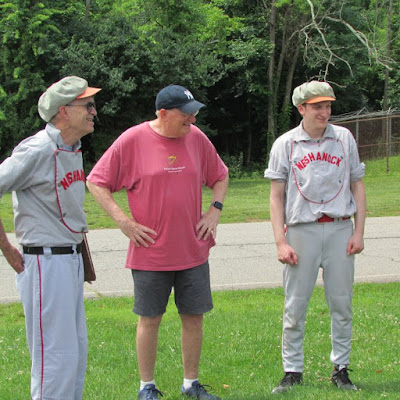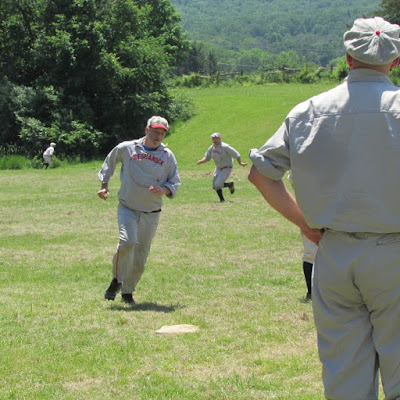Whether or not history repeats itself is questionable, but there are moments when it seems to be painfully true. The early innings of Saturday's first game at Greenway Meadows Park in Princeton between the Neshanock and the Monmouth Furnace Club were a case in point. Back in May, the two clubs played almost four innings when the skies opened wiping out the contest. At least that time the bad weather was forecast. On Saturday the two teams were settling into the first match when again the skies opened and it looked like the games were in doubt. However the two teams manfully played through the rain which eventually abated, allowing for the completion of both seven inning matches. The games were the latest installment in an annual event hosted by the Historical Society of Princeton. In Neshanock circles it's also known as the annual "Tumbles" game because it was the 2011 event when Ken "Tumbles" Mandel joined the team. It's safe to say the Neshanock, not to mention vintage base ball, have never been the same and we'll just leave it at that.
Flemington won the toss sending the Monmouth team to the striker's line. After they were retired without incident, the Neshanock tallied three times, followed by four more in the second and six in the third for a commanding 13-0 lead. Flemington had one more big inning, scoring five times in the fifth in route to a 19-0 victory. The Neshanock offense was led by Danny "Lefty" Gallagher and Mark "Gaslight" Granieri both of whom had four hits and recorded a clear score for the match. Jim "Jersey" Nunn contributed three hits as did newcomer Pete Disciasio, who played well in his Neshanock debut. Also contributing offensively were Tom "Thumbs" Hoepfner, Joe "Mick" Murray, Chris "Low Ball" Lowry, Bobby "Melky" Ritter and "Tumbles" with two hits apiece. One of "Thumbs" hits was a grand slam home run that made up for a lack of distance with perfect placement. "Melky" and Rene "Mango" Marrero shared the pitching duties allowing only four hits, supported once again by stout Flemington defense.
After a brief respite, Flemington struck with a vengeance in the top of the first tallying 13 times before the side was retired and then adding five more runs in the top of the second, putting the game out of reach. While there wasn't much drama after that, the game did present some interesting scenes, especially "Tumbles" pitching with "Gaslight" serving as the umpire, but you had to be there to fully appreciate it. Leading the way offensively in the 30-2 win was Tom "Thumbs" Hoepfner who had five hits and a clear score, a feat matched by "Jersey" with four hits. Joining "Jersey" in the four hit category were "Lefty," "Mango," "Low Ball" and Tom Priori in his third game for the Neshanock. Not far behind Tom was fellow newcomer Joe Tomlinson with three hits. Also recording three hits was Jeff "Duke" Schneider while Joe "Mick" Murray and "Gaslight" had two each. Next week the Neshanock are off for the July 4th holiday, but return to action on Saturday, July 10th at historic New Bridge Landing in Bergen County. After that it's off to Gettysburg where we look forward to seeing our friends from the Monmouth Furnace Club.
As noted in the account of last weekend's matches, Flemington's second game 3-1 victory was one of the lowest scores in team history. Admittedly, it was only a seven inning game, but the score was rare enough to merit further analysis. As one might expect, the Neshanock played almost errorless ball, committing just a harmless first inning muff. Also to be expected was the high number of foul outs (7 or 1/3 of the total), outs where the ball didn't even make it into fair territory. It should be noted however that the Neshanock earned those outs, especially two fine plays by Chris "Sideshow" Nunn and Joe "Mick" Murray. Far more unusual is that only five Liberty strikers were retired at first base, all on ground balls to the pitcher, second or first base. Not a single ground ball was hit to the left side of the infield eliminating the need for the longer and more difficult throw to first. The balance of the outs came on six fair bound outs and three fly outs. All told, the Liberty only had five base runners, one on the muff and four through base hits, only one of whom crossed home plate. Solid Neshanock defense had a lot to do with the low score, but the total absence of ground balls to the left of second seems significant.
Since Flemington batted second, the Liberty only had to record 18 outs, but the chances faced by the New Brunswick team were more difficult. Only two Neshanock strikers went out via foul balls while seven were retired at first base. Of the latter group, all, but one were hit to the left side of the infield and the Liberty third baseman and shortstop made a number of strong stops and throws. After that eight or almost half of the 18 outs came on bound outs, divided between the infield and outfield with the final out coming from a fly ball. The Liberty played flawless defense without a single muff, but the eight Neshanock hits were the reason why Flemington tallied two more runs than the New Brunswick team. While it was enough to win, the low Neshanock score seems due to the quality of the Liberty defense since there wasn't anything out of the ordinary in how the outs were recorded. Perhaps more importantly, the pitching for both teams, while good, didn't seem to be different in any way could account for the low scores for both teams.
Naturally, or at least naturally in my case, the low score made me wonder how common such low offensive numbers were back in the 1860s. Since the Neshanock - Liberty game was played under 1864 rules, the only real comparison is with that season, the only year called balls (introduced in 1864) and fair bound outs (eliminated after 1864) were part of the game. A review of the scores listed in Marshall Wright's The National Association of Base Ball Players: 1857 to 1870 revealed the two lowest scoring games of that season were an 8-6 Excelsior (Brooklyn) victory over the Union Club of Morrisania and a 9-3 defeat of the Empire Club by the Active Club (both of New York). It turns out, however, that the Excelsior - Union game was a fly game, that is, the bound rule was not used, leaving only the second game for some basis of comparison. Interestingly, the Active Club should only have scored eight runs due to an umpire's error. While pitching to the Active leadoff batter, Empire pitcher, Alphonse "Phonny" Martin committed a balk and for some reason, known apparently only to himself, the umpire awarded the batter first base and he proceeded to work his way around and score.
Both teams in the 1864 game took advantage of foul outs, making a little over 20% of the 27 outs in that manner. The Active Club relied far more on infield play recording 15 outs, more than 50% of the total. The Empires depended far more on fly outs - 11 compared to only six for the Active. No bound outs were recorded in the box score so it's not clear if there weren't any or if they are counted somewhere in these other categories. Based on the eyewitness newspaper accounts, it seems the relatively low 1864 score had more to do with the pitchers than the defense behind them. Interestingly, Charles Walker for the Active Club and Martin for the Empire team were almost mirror opposites. Martin was known for how he mixed up slow pitches while Walker's reputation was based on his "speed and command," although there were questions about the legality of his delivery. It seems, therefore, that the major difference between the two low scoring games (1864 and 2021) is the role pitching played in the low run production. While this is far from scientific analysis that also appears, at least to me, to be a major overall difference between contemporary 1864 matches and vintage base ball - food for further thought.
























